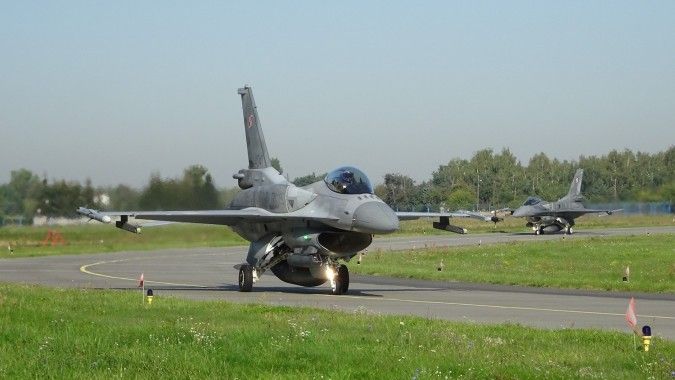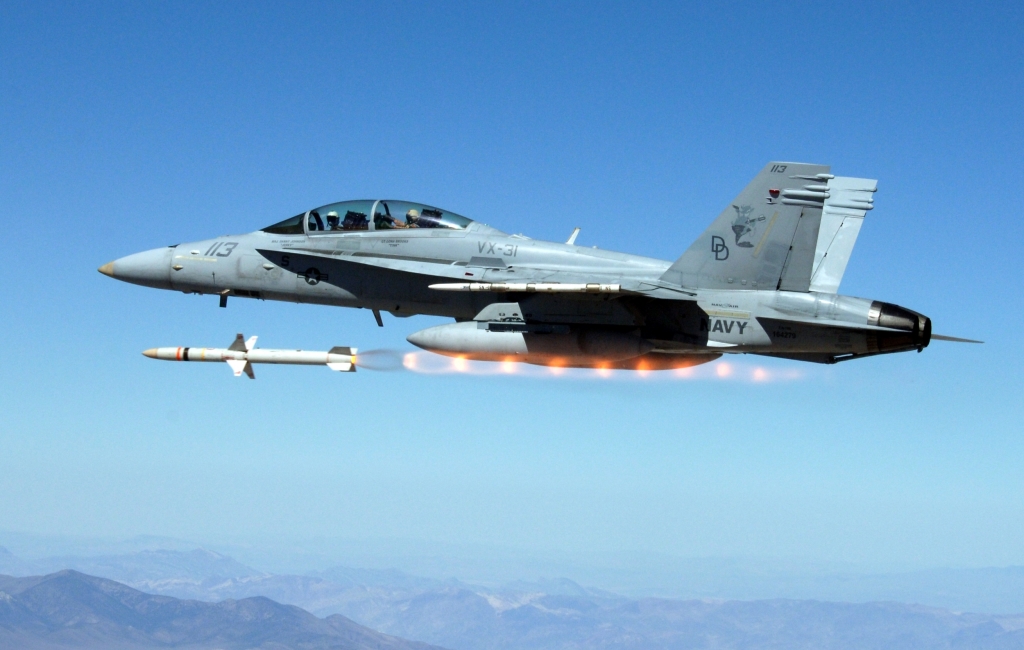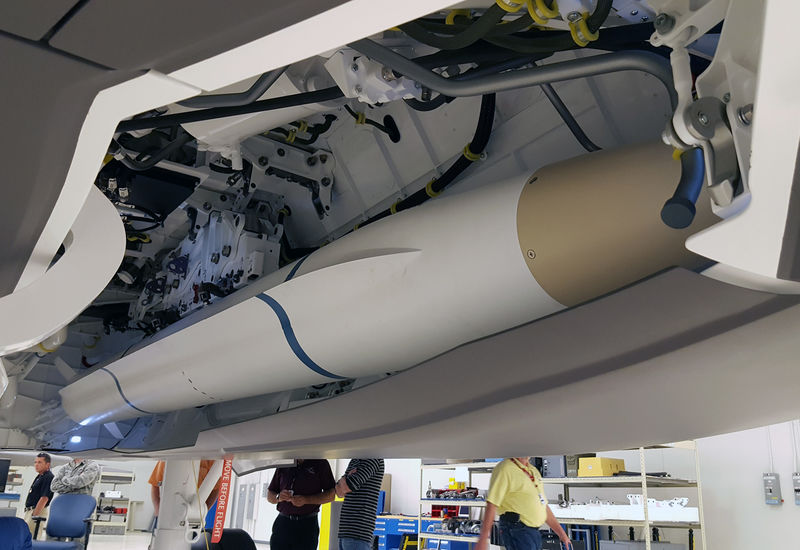Armed Forces
Defence24 Day: Polish F-16 fighters against anti-access systems

Although the Air Force’s priority remains the introduction of the 5th generation Harpia fighters under the F-35 program, the F-16 remains the basis of tactical aviation. Proper use of these fighters will also be crucial for the functioning of the entire Polish tactical aviation, even after the implementation of the F-35. During the Defence24 Day conference, it was emphasized that the F-16s also have a role to play in the context of breaking the anti-access systems of a potential adversary.
The integration of the F-35 aircraft in the joint combat system and the most effective use of the features of this fighter in conjunction with the F-16 already possessed by Poland is one of the greatest challenges faced by the tactical aviation of the Polish Air Force - emphasized participants of the panel "Challenges of military aviation in the eastern NATO Flank” organized during the recent Defence24 Day Conference. The signing of the FMS contract for the supply of 32 F-35A fighters, which took place in January this year, is only the first step towards achieving appropriate operational capabilities by Poland.
Paradoxically, an important role - not only now, but also after the delivery of the F-35 fighters - will be played by the way Poland uses its fleet of F-16 aircraft. They are the ones that currently have the greatest combat capabilities, and after introduction of F-35s into service, they will interact with them, because the fifth generation squadrons will not be enough to perform all tasks. Appropriate use of F-16 fighters may also prepare the crews of future Polish F-35As to perform their missions.
One of such tasks, related to the geographical location of Poland in Central and Eastern Europe, is breaking the anti-access system (A2 / AD) belonging to a potential opponent. In the case of Poland, this means that a significant part of the country's territory remains within the range of Russian S-300 and S-400 air defense systems, which may jeopardize air operations on NATO's eastern flank.
On the other hand, the location of Poland also offers some opportunities, for example related to the identification of threats. Jay Annis, representative of Northrop Grumman, drew attention to this issue during the discussions at Defence24 Day. He stated that the F-16 machines could be involved in identifying threats from air defense systems - We need to take advantage of Poland's position as NATO's easternmost country and the important role that Warsaw plays in defense. Make full use of the capabilities of the systems you now have and plan to acquire for the future. So the identification, when it comes to Kaliningrad or Belarus, can be based on the F-16. (...) You are also able to build a doctrine of capabilities and also on the basis of the F-16 organization - data acquisition, intelligence and tactical operations - he said.
By performing flights in the Polish operational environment, the F-16 can simultaneously perform reconnaissance functions. This is important because Polish aircraft of this type - which is natural - are present here permanently, while allied fighters - at least so far - only rotational.
F-16 as "Wild Weasel"
The F-16 can also be used to detect and engage components of anti-access systems. For this purpose, they can use various types of precision armament systems, in particular specialized, dedicated anti-radiation missiles – self guiding at sources of radiolocation radiation. The Technical Modernization Plan for 2021-2035, as well as previous edition of the TMP until 2026, includes the acquisition of the Advanced Anti-Radiation Guided Missile (AARGM) anti-radiation missiles for F-16 fighters.

Missiles of this type are created by converting the existing AGM-88B / C HARM, but they receive new multi-sensor guidance systems (with new generation passive digital anti-radiation homing head, active millimeter radar and INS / GPS system). So far, they are used on American and Australian Hornet, Super Hornet and Growler and Italian ECR Tornado aircraft, they have also been acquired by Germany for aircraft of the same type. However, AARGMs are also compatible with F-16 fighters, initial integration went without technical problems.
AARGM also makes it possible to engage non-radar targets thanks to the use of the INS / GPS system, if their coordinates are known. It can also destroy elements of air defense non-emitting systems, even after commencement of displacement, thanks to the use of millimeter radar. The new digital anti-radiation homing head also has the ability to identify and classify threats from air defense systems. The system itself is therefore a tool not only to counter threats, but also to identify them.
The information obtained by the AARGM system can be forwarded, for example using the Link 16 protocol. This, in turn, opens the way for the system to be used for coordinated strikes, both for ground and surface targets. Thus, it is possible to imagine carrying out a strike with AARGM missiles and subsonic anti-ship missiles on a group of combat vessels having an air defense system, thus use of effectors with different characteristics increases the chances of success.
The AARGM-ER version with much better characteristics is also under development by the US Navy. It will combine a guidance system based on AARGM solution with a new airframe design and propulsion system, providing the ability to engage targets at twice the distances and at twice the speed of the existing AARGM. It will also be able to be carried in the internal weapon bays of the F-35 fighter. The United States Air Force has already decided that their long-term SiAW (Stand-in Attack Weapon) program will be based on the AARGM-ER missile technology, with new elements, such as a warhead. Poland has been also interested in AARGM-ER, because the request for price and availability (LOR P&A) that was submitted in regard to this case in 2018 concerned both standard AARGM and AARGM-ER.
The AARGM-ER and SiAW missiles will therefore be integrated with the F-35 fighters by definition, although the AARGM-ER missiles will be the firstly delivered to US Navy for the Super Hornet and Growler aircraft. According to the draft budget of the US Department of Defense for 2021, the first AARGM-ER (LRIP) small-series production contract is to be awarded in the third quarter of fiscal year 2021 (in the second quarter of the calendar year 2021), and initial operational readiness - obtained in 2023. At the same time however, the integration of the SiAW version with the internal armament compartment of the F-35 fighters is to end - according to the same document - in the fourth quarter of fiscal year 2025.
Given the time needed for certification, production launch, and meeting the priority needs of the U.S. Armed Forces, it can be expected that the new missiles will be available to foreign users around 2030 or later.
The exploiting of anti-radiation missiles - as if by definition - is one of the most difficult tasks faced by pilots. It is often dealt with by specialized squadrons, for example in the USA, where they are nicknamed "Wild Weasels". One of such units, responsible for the European and African territories, is the USAF 480th squadron Spangdahlem AFB in Germany, which is to be transferred from Germany to Italy. This unit often participates in exercises in Poland, although reports of its possible permanent transfer from Germany to Poland, appearing before President Duda's visit to Washington in June, have not been confirmed. Such units also create special databases of threats from air defense systems, based, inter alia, on various sources and data from reconnaissance or intelligence.
A similar database will also have to be established in Poland when creating or actually recreating anti-radiolocation capabilities. At the same time, the preparation of combat ready pilots and development and exercising of tactics for the application of anti-radiation measures will be carried out gradually.
It may be helpful to equip F-16 fighters with this type of armament - in line with the assumptions included in the Technical Modernization Plan. They will form the basis of the potential of Polish tactical aviation for the coming years, operating for the vast majority of the time in the area of NATO's eastern flank, i.e. in the area of potential threats. Acquiring anti-radiation armament systems will enable them to be used not only as platforms for collecting data on dangers, but also - in the event of a possible crisis or conflict - to neutralize them.
The introduction of the Suppression of Enemy Air Defences (SEAD) and Destruction of Enemy Air Defences (DEAD) mission and AARGM anti-radiation missiles on the F-16 would also enable the "smooth" transition of pilots to F-35A fighters armed with missiles of a new generation, when they reach combat readiness, and - not least - the use of previously developed tactics, techniques, procedures and threat databases.

According to the draft budget of the Department of Defense for 2021, the production of the AARGM missiles in the AGM-88E (standard) version is expected to end in fiscal year 2025. This is done by converting the existing AARGM AGM-88B / C components and adding new components to them, related to primarily with a guidance system. While the countries that are equipped with HARM missiles today can use their own supplies (such as Germany or Italians do), new users, as it were, automatically have to obtain HARM components to prepare new missiles. So if Poland decides to acquire these missiles, it will be necessary to both secure stocks of HARM missiles and enter production tranches of the current users. And this means that the relevant decisions should be taken within a horizon that takes into account the duration of the Congress notification, production, etc.
AARGM not only in the air?
The AARGM missiles (both in the standard and ER versions) are still being developed. However, it is not only about modifications introduced in connection with the evolution of threats, but also about the concept of their use. In 2018, at the AUSA exhibition, a ground / surface launcher for these missiles was presented. The ongoing AARGM-ER program, as well as the inclusion of the US Air Force (SiAW) in it, are the next steps towards extending the use of this type of weapon. It has been known for some time that the US Military is also considering the integration of AARGM missiles with the IBCS combat management system that Poland acquired in the first phase of the Wisła program (and is also considering in the Narew SHORAD project). As a result, information from platforms equipped with these missiles on threats from air defense systems or, for example, parameters of the electromagnetic emission of artillery radars, could be transmitted directly to land units dealing with air defense, increasing their situational awareness.
During last year's IBCS tests, the ability of the F-35 fighter to transmit data on air targets to the IBCS system in real time, in a quality that allows direct fire of anti-aircraft missiles, was also tested using an experimental station. The combination of tactical aviation and ground-based air defense units, including IBCS, may therefore multiply the capabilities of the entire destruction system.
In the United States, conceptual work is also underway to develop the "joint fires" capability - strengthening the interaction of anti-aircraft and field artillery based on the IBCS system. As IHS Jane's writes on this subject, it reported, among others Gen. Brian Gibson, head of the Cross Functional Team responsible for air and missile defense.
If long-range surface-to-ground missile artillery units, fighters and air defense units could be directly connected, it would be possible to engage radar stations detected by planes with missile artillery within a single fire system. And this makes it much easier to break air defense, if only because the number of ammunition carried by planes is always limited.
The introduction of anti-radiation missiles to the equipment of Polish F-16 and F-35 aircraft may therefore be an important element, allowing them to operate effectively in hazardous conditions. They can become an important part of the all-domain, joint fire system that the Air Force will create based on the 4th and 5th generation aircraft.By its very nature, however, the building of such capabilities will have to be gradual and spread over time. Its first step may be to commit to the SEAD/DEAD mission and equip and train Polish pilot cadre’s to use the F-16 fighters in a way that will enable them to recognize, but also to combat, elements of the anti-access systems of a potential enemy. Such solutions can provide not only combat abilities, but also a certain potential that can be further used in the creation of a joint, interoperable combined combat system.
Article prepared in collaboration with Northrop Grumman
